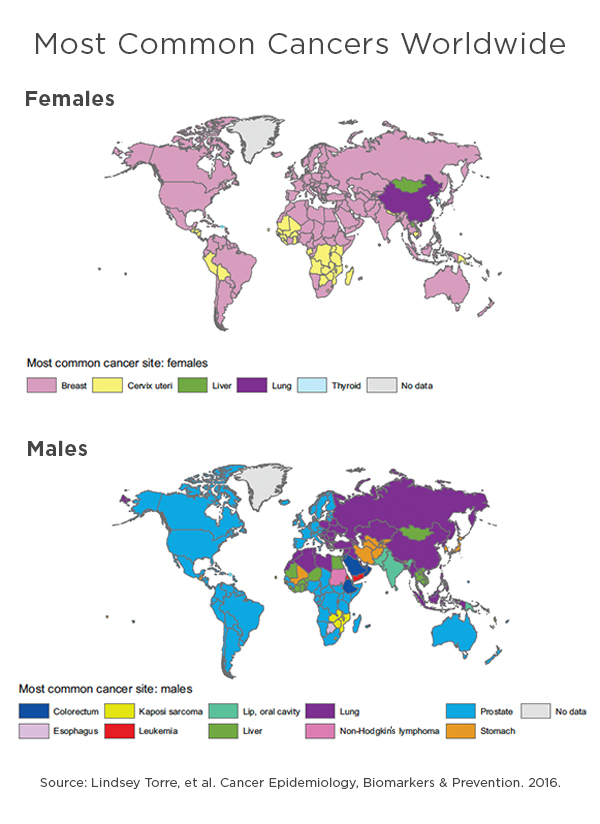In the U.S., and most of the world, breast cancer is the most common cancer to strike women. But for Chinese women it's lung cancer, and in some African, and South and Central American nations, it's cervical cancer. For men, prostate cancer dominates in the U.S. and Western Europe, while lung cancer is the most common form of the disease in Russia and China.
Global differences in cancer rates are partially explained by genetics. But, moreover, they reflect differences in lifestyles and environmental exposures around the world - whether it's viral infections causing cervical cancer or high rates of lung cancer in countries where smoking is prevalent.

If we look at the global patterns of cancer rates we can see the intimate connection between the environment and our health. These maps - adapted from a paper by Lindsey Torre and colleagues, which was published in the January edition of Cancer Epidemiology, Biomarkers and Prevention - show the most commonly diagnosed cancers in every nation. Investigating regional and country-specific differences in diet, lifestyle and toxic exposures can help us understand the patterns.
Females
- Breast cancer is by far the most common cancer among women worldwide. Factors that prolong estrogen exposure, such as menopausal hormone therapy, early puberty and obesity, are major risk factors.
- Cervical cancer is most common in lower-income African and South American nations that have a high incidence of human papillomavirus, or HPV, infections.
- Lung cancer is most common among Chinese women. Even though very few Chinese women smoke, many homes, particularly in rural areas, use coal or other biofuels to cook, creating very smoky living environments.
Males
- Prostate cancer is common in many higher-income countries. Advanced screening allows for greater detection of the disease, but obesity and diets high in animal fats may be risk factors.
- In Eastern Europe, Russia and China, lung cancer rates among men are high because smoking remains popular.
- Many men in India chew tobacco, often with areca nut. Both substances are known to cause oral cancers, which are relatively uncommon in western countries.
- Stomach cancers are more prevalent in cultures that consume more salted and preserved foods, as well as in regions with high rates of Helicobacter pylori bacterial infection. The bacterium is commonly associated with ulcers.
- Liver cancer is more common in India and sub-Saharan Africa, which have high rates of hepatitis, as well as in the Asian Pacific, a tropical region where people may be exposed to aflatoxins from mold growing on food.
The causes of cancer are many and complex. But looking at global patterns underscores the important role our environment and lifestyles play in both cancer development and prevention.